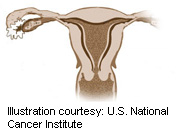Transvaginal sonography, a feasible and economic imaging modality
MONDAY, Aug. 31, 2015 (HealthDay News) — Transvaginal sonography (TVS), performed by a dedicated gynecologic radiologist, is comparable to magnetic resonance imaging (MRI) for diagnosing and staging local cervical cancer, according to a study published online Aug. 21 in the Journal of Clinical Ultrasound.
Fiachra Moloney, M.D., from Cork University Hospital in Ireland, and colleagues compared the diagnostic accuracy of TVS with MRI for the local staging of cervical cancer in 46 patients diagnosed with invasive carcinoma of the cervix over a three-year period.
The researchers observed a strong correlation between MRI and TVS in the assessment of tumor volume in both early-stage and advanced-stage disease (P < 0.0001). Both technologies had a sensitivity of 80 percent, a specificity of 50 percent, and a diagnostic accuracy of 63.6 percent for the detection of stromal invasion in early-stage disease. Sensitivity, specificity, and diagnostic accuracy rates varied for MRI and TVS detection of parametrial invasion: sensitivity of 40 and 86 percent, respectively; specificity of 78.8 and 20 percent, respectively; and diagnostic accuracy of 89 and 78.7 percent, respectively. However, in a matched-sample analysis there was no statistically significant difference between MRI and TVS in the assessment of stromal or parametrial invasion (P = 0.06).
“TVS performed by a dedicated gynecologic radiologist is a feasible and economic imaging modality with a diagnostic accuracy comparable to that of MRI,” the authors write. “It may be used as an adjunct to MRI for the local staging of invasive cervical cancer or to allow for rapid and confident triage of patients into operative and nonoperative categories for management in the gynecologic outpatient setting.”
Copyright © 2015 HealthDay. All rights reserved.








